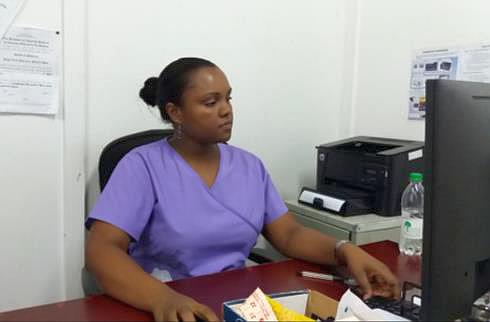The Ministry of Public Health Guyana has recognized the importance of Information Systems for Health (IS4H) and its role in improving access to healthcare amidst much of the information systems being fragmented, and many being manual and paper based. In keeping with a vision for standardization, interoperability and modernization, the Minister of Public Health, Hon. Volda Lawrence tasked her Ministry to start the implementation of a comprehensive information systems initiative under the framework of IS4H endorsed by CARICOM. The outcome of this was a proposal to pilot a Guyana Health Information Systems (GHIS) at the East La Penitence Health Center (ELPHC), in an outpatient setting. PAHO/WHO was requested to provide technical cooperation in this important endeavor.
In July 2017, PAHO/WHO conducted a rapid assessment of Guyana’s existing national IS4H and presented several recommendations for strengthening, as well as opportunities for technical cooperation support from PAHO/WHO, including providing project management and technical support for the implementation of a GHIS pilot before the end of 2017.
Based on this initial assessment PAHO/WHO conducted a follow-up on-site technical mission between8 - 18 August 2017 to follow-up on the recommendations emerging from the IS4H Rapid Assessment, to develop a Work Plan for two PAHO/WHO Technical Consultants to be on site to support the GHIS pilot. Outcomes of that on-site mission included a detailed pilot work plan and requirements documentation for key pilot functionality. A key area that resulted from this pilot was the re-formation of the Strategic Information Technical Working Group (SI-TWG), to oversee all areas of IS4H and the development and implementation of the GHIS.
 Dr. Keisha Chin, Manager, East La Penitence Health Center at work on the GHIS. Photo credit: PAHO/WHO Guyana, Ms. Angela Hoyte.
Dr. Keisha Chin, Manager, East La Penitence Health Center at work on the GHIS. Photo credit: PAHO/WHO Guyana, Ms. Angela Hoyte.
Dr. Keisha Chin, Facility Manager, East La Penitence Health Center: "Despite some challenges, the GHIS pilot has overall been beneficial to myself, my staff and by extension my patients."
The second onsite technical visit included the visit of the two technical consultants, Dr. Camila Murga, and Ms. Lynsey Turchet, who were in country for the period of September 25 to December 8, 2017. The objective of this mission was to provide project management and technical support for the GHIS pilot implementation and to develop a number of enabling components to strengthen the overall development and deployment of the GHIS.
Key achievements included a project management approach, with key timelines and outputs. A Project Charter was developed, with the Minister of Public Health as the executive sponsor. Through consultation with the SI-TWG, the Ministry of Health’s Management Information Systems Unit and clinicians from the ELPHC, key deliverables included a GHIS Pilot Project Charter, Requirements Documents, a Stakeholder Communication Plan, a Change Management Strategy, a System Testing Strategy, Standard Operating Procedures and a Monitoring and Evaluation Framework. It was also recommended that a Team Lead and Project Lead be hired to oversee current and continuous sustainable development of the GHIS. All the above development within the project management framework served as a best practice for IS4H development within the country.
Site visits were done at the facility to improve security, IT and physical infrastructure. Assessments were also done to determine the computer literacy levels of staff to inform training. Visits were also done by the development team to record workflows at the facility in order to successfully map these to the GHIS. In addition, a project implementation team was formed to oversee the GHIS development, with a representative being present at the facility at all times during the deployment and pilot. Their roles and responsibilities included ensuring adherence to timelines, that adequate testing and bug-fixing was completed and subsequent deployment was properly done. They were also tasked in confirming all documentation and training was completed, and ensuring overall success in implementation of the project.
The pilot started in February 2018, and covers areas of the operations of the center from patient registration, triage, consultations and examination, all the way to lab and prescription orders.
The facility manager, Dr. Keisha Chin, reported that implementation of the system was well done. “We were able to keep constant contact with personnel from the Ministry of Public Health, as well as PAHO/WHO staff and consultants, who visited regularly and updated us on everything that was taking place, as well as including me and my staff to give feedback during development and implementation”, said Dr. Chin.
Dr. Chin has also stated that despite challenges with a newly implemented system, the work has become more efficient, information is easier to access, is better organized and thus used more effectively, and the GHIS is very much appreciated and welcomed by all staff who have interactions with the system. Patients see this as a positive, in terms of modernization, and faster processing of their patient records, and are happy with the large reduction in waiting time regarding the access to their patient information, which was done manually with the previous system. This has also resulted in in the patients attending their follow-ups on a more regular basis.
To note, an evaluation of the GHIS Pilot was recently done by CDC/ITech.
The implementation of this program has the potential to lead much change across the health systems. This has already started with the formation and work of the SI-TWG, as well as the country working to create and implement a comprehensive eHealth Strategy. The lessons learnt are also being leveraged to work toward expansion of IS4H, as well as leading to the recognition of the need for more human resources, especially in specialized areas in relation to health informatics. It is also noted that this project is the result of strong political commitment from the highest levels.
